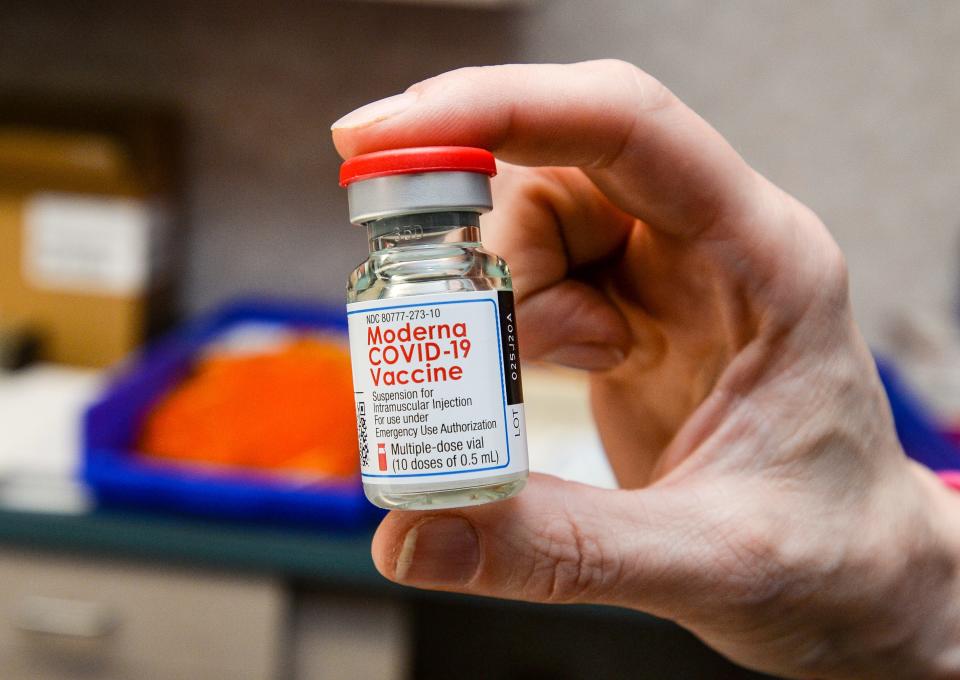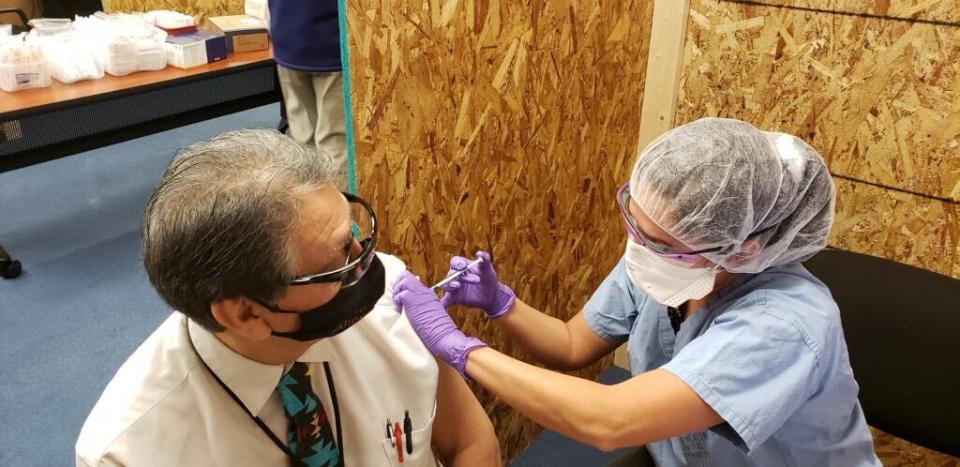Native American tribes receive COVID-19 vaccines, and health officials work to ease fears about taking it
When the COVID-19 vaccines arrived at the Bay Area Indian Health Center in California's Santa Clara Valley, Miriam Mosqueda of the Chichimeca Guamare tribe almost didn’t take one. She was afraid.
But the 26-year-old staffer thought of her immunocompromised grandparents, whom she hadn't seen since March.
She thought of never again sipping her grandmother’s traditional vanilla atole while she told her stories, or never hearing her grandfather’s laughter as he insists she pick lemons from his tree.
Her culture reveres elders, and her grandparents helped raise her. “They’re like our third and fourth parents,” she said.
“I was like, I have to get this vaccine. If that means that I can protect them, too … and safely see them, then I will do that,” she said. “I can’t not take the opportunity to protect our community.”
Before the new year, Mosqueda, the center's youth professional development counselor, went in 30 minutes before the last round of the first dose was administered to the center's staff.
The center is one of 340 tribal health programs or urban Indian organizations nationwide to receive vaccine allocations from the federal Indian Health Service. Tribal nations had the choice to receive vaccines from the IHS or their states.
Navajo women are 'sacred' keepers of the cultural flame: They're also particularly vulnerable to COVID-19.
The IHS has distributed 290,900 doses of the Pfizer and Moderna vaccines among its 12 geographic areas, and more than 74,000 first doses have been administered, according to the U.S. Centers for Disease Control and Prevention. Tribal health care workers and Native residents of long-term care facilities began receiving vaccinations last month as part of Phase 1 of the nation's coronavirus vaccine rollout.
COVID-19 has disproportionately affected Native communities, in part because of long-standing social inequities that have put American Indian and Alaskan Natives at higher risk for contracting the virus.
A CDC study found that among 23 states with data on race, American Indian and Alaskan Native people were 3.5 times more likely to be diagnosed with the coronavirus than white people and four times as likely to be hospitalized.

“It's been devastating for many of our community members,” said Sonya Tetnowski, CEO of the Indian Health Center of Santa Clara Valley. The state has one of the largest populations of American Indians, at more than 720,000, and 109 federally recognized tribes.
“Because we're serving a population that already has significant challenges just day to day, adding the coronavirus ... added to that stress and pressure of that community," she said. Many patients at the center, which also serves Hispanic and migrant workers, suffer from diabetes, hypertension and heart disease, making them vulnerable to the virus.
As the virus hits their communities hard, tribal leaders grapple with the challenge to help members feel comfortable taking the vaccines and understand its safety for most people. Injustices against tribal communities have planted seeds of doubt in many.
'Bringing all the facts to the table'
Health centers are the nexus of making sure Indian communities get vaccinated, and respected elders and tribal leaders within the groups leverage their influence to help get the message out.
People of color, including indigenous people, are more likely to rely on trusted voices within their own communities for information about the pandemic and the vaccine, a study by Northeastern University that tracked online behaviors suggests.
“It’s helped tremendously in Indian Country for people to have a transparent perspective,” said Virginia Hedrick, executive director of the California Consortium for Urban Indian Health. The group streams Facebook Live question-and-answer sessions every other week.
'Wary of government': Hit hard by COVID-19, some tribal members in Montana hesitant to get vaccine
"It's about transparency. It's about bringing all the facts to the table," said Hedrick, a member of the Yurok Tribe who grew up on the tribe's rural reservation. She said connecting CCUIH's messaging about the vaccines to American Indian values, such as community, has been essential.
“We don’t know about this vaccine’s ability to prevent transmission. What we do know is that it will save lives. And we do know as Indigenous people that that value resonates with us – that we really have to meet our prayers halfway," she said. "So when we’re praying for health and wellness and long life, we have to do the things that get us there.”
CCUIH works with another agency to create educational digital and print flyers about the vaccines featuring relatable images and taglines.
"When they see images that don't resonate with them, when they see taglines that are not important to them, they put the material to the side," she said. "'That's not important to me. That's not inclusive of what we do as a family.' Then it's a total missed opportunity."
In southeastern Minnesota, the Prairie Island Indian Community on the Mississippi River had early buy-in on the vaccines from community elders.
In mid-December, the tribe hosted a Zoom meeting for community members with elders, tribal council members and Prairie Island Health Center’s primary doctor to answer questions and talk about the vaccines.
“The majority of tribal elders have accepted the vaccine. They really feel a responsibility to protect their community,” said Katie Halsne, director of clinical operations for Neopath Health, which runs the Prairie Island clinic.
Read more on race and identity: Sign up for USA TODAY’s This Is America newsletter
The first round of vaccines went to health care workers at the clinic and long-term care facility, as well as residents and first responders, Halsne said, followed by about 80 elders and 200 members considered high-risk.
Emphasizing protecting elders has been key to helping communities understand the importance of the vaccines. "We do have a profound respect for our elders. They are our encyclopedias. They are our libraries. They cannot be replaced," Hedrick said.
Tetnowski said she and other IHC leaders post on their personal social media accounts about the vaccines.
"A lot of community members who were kind of on the fence ... know people now who've received it," she said, "who were comfortable with the way the process went."
'I can say I'm alive, and I'm doing OK'
In Sioux Falls, South Dakota, a team of mental health therapists helps guide the Flandreau Santee tribe through the stress brought on by the pandemic, discussing the vaccines with each patient. Doctors at other clinics make a point of publicly taking a vaccine to model its safety.
Family physician Courtney Keith said she wanted to be one of the first to receive the vaccine not just because she’s a health care worker treating patients but to show the tribal community the vaccines are safe.
"I work with a clinic that has had an abusive history with medicine," she said after receiving her first dose in December. "The reason I want to be one of the first (to get the vaccine) is to show I have confidence, and so six weeks down the road, when people are thinking and saying, 'Should I get it?' I can say I’m alive and I’m doing OK."
'A new chapter': Flandreau Santee Sioux distributes first COVID-19 vaccines
At Minnesota's Prairie Island clinic, Halsne said staff doled out vaccines to 140 people Wednesday. Of the 224 people they offered vaccines, 27% refused. Word of mouth brings people in, she said.
Blackfeet Nation health care workers in Montana received their first doses of the Moderna COVID-19 vaccine before the Christmas holiday. The Nation peaked in cases mid-October at about 400 diagnoses.

In preparation for vaccine distribution last week, the tribe's COVID-19 Incident Command shared an announcement featuring a shaggy "rez dog" puppet who interviews a nurse practitioner about the vaccines.
In the video, the "Rez Dog Rep" asks the nurse questions ranging from the cost of the vaccines to whether he will need to continue to wear a mask after being immunized to who gets it first and potential side effects.
"Indian people like humor," said the tribe’s public information officer, James McNeely. "The idea of the PSA is to help ease people's minds, give them a sense of comfort and an education on the vaccine."
Tracking COVID-19 through 'population lens'
Andrea Klimo, who leads the IHS COVID-19 Vaccine Task Force Distribution and Allocation Team, said allocations were calculated based on population and storage abilities.
“Each geographical area has their own considerations," Klimo said. "They have a different population lens, they have different geographical constraints sometimes and some of them have different capabilities of storing the vaccines at various temperatures.”
Klimo said IHS relies on larger tribal health centers to distribute vaccines to surrounding rural tribal communities.
"Some areas have a really robust hub-and-spoke model," she said. "We send to our hubs, and then they distribute out to the more rural isolated locations."
One such tribe of varying needs using this model is the Navajo Nation, one of the largest in the country with about 172,000 residents living on land spanning more than 27,000 square miles across three states.

Last year, the tribe had the highest infection rate per capita, despite aggressive preparation a month before its first confirmed case.
The tribe's COVID-19 task force enforced policies and protocols, decreasing the case count significantly, according to data from the Navajo Department of Health.
Amid a surge nationwide, tribal authorities have scrambled to keep a lid on cases while prioritizing vaccine distribution to health centers with proper storage.
The Kayenta Health Center in Arizona, a rural hospital serving Navajo Nation residents, has a smaller freezer than other health centers that serve the tribe. Officials worked to get the vaccine to hospitals with more space and proper equipment to store doses, since the Pfizer vaccine requires such cold temperatures.
"We are placing it strategically in those freezers so that we can then take that vaccine to the other health centers and hospitals," said Loretta Christensen, chief medical officer for the Navajo area Indian Health Service.
More: Navajo Nation receives 1st shipment of COVID-19 vaccine
Santa Clara Valley hosts a diverse and robust population because of the Indian Relocation Act of 1956 that forced Native people to move from reservations and assimilate into urban areas. The intertribal makeup makes health centers such as IHC and other hubs integral to making sure members of different communities get vaccinated when the vaccines become available to the general public.
The day after Mosqueda got vaccinated, she was finally able to visit her grandparents.
"I could worry about myself getting side effects after the vaccine, or I can think bigger picture," she said. "If I have chills the next two, three days but in the long run, my community as a whole will be safer, then I'm OK with that."
Contributing: Danielle Ferguson, Sioux Falls (South Dakota) Argus Leader, and Chelsea Curtis, The Arizona Republic
Reach Nada Hassanein at nhassanein@usatoday.com or on Twitter @nhassanein_.
This article originally appeared on USA TODAY: American Indian tribes get COVID-19 vaccines, aim to ease hesitancy

 money
money 